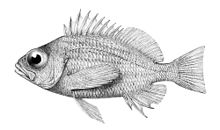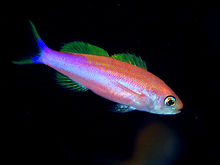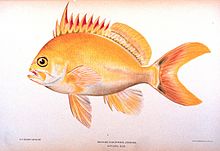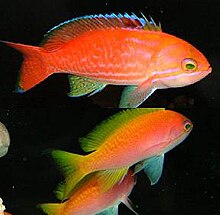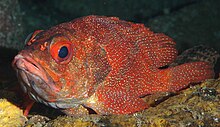Anthias
| Anthias | ||||||||||||
|---|---|---|---|---|---|---|---|---|---|---|---|---|
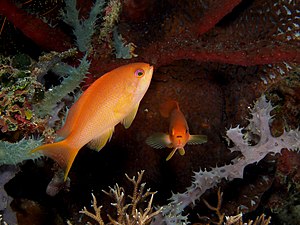
Jeweled Anthias ( Pseudanthias squamipinnis ) ♀ |
||||||||||||
| Systematics | ||||||||||||
|
||||||||||||
| Scientific name | ||||||||||||
| Anthiadinae | ||||||||||||
| Poey , 1861 |
Tilefish (Anthiadinae) are among the family of groupers and live with almost 230 species in tropical and subtropical seas. Most of the species in this subfamily are extremely colorful.
Distribution, habitat and way of life
Most species come from the Indo-Pacific , some also live in the Atlantic , Anthias anthias also occurs in the Mediterranean . Usually the 6-18 cm large animals live in large schools with hundreds to thousands of specimens on the outside of the coral reefs and feed on animal plankton . Species with a small number of gill rakes , such as Acanthistius sp., Hypoplectrodes semicinctum , Trachypoma macracanthus and most Plectranthias species, tend to be solitary, avoid open water and feed primarily on larger prey such as crustaceans and small fish. Many anthropoid species are extremely common in the reefs. In terms of numbers, they represent a substantial part of the fish fauna. Their predators include groupers , scorpion fish and moray eels . Anthias seek shelter between the corals when in danger.
features
Most species of anthias reach lengths of ten to twenty centimeters (40 cm for Meganthias ). Their bodies are usually spindle-shaped and laterally flattened, but there are also very high-backed species. The dorsal fin is continuous and long, the caudal fin is usually deeply forked and / or elongated like a filament at the upper and lower edge.
The dorsal fin is supported by 10 to 13 hard and 13 to 16 soft rays. In the anal fin there are 6 to 9 hard and 13 to 16 soft rays. The caudal fin is usually supported by 13 branched fin rays. The maxillary is scaly in most species.
Males and females of the very brightly colored, red, orange or purple species are often colored very differently and thus show a pronounced sexual dimorphism . Some species change color during mating.
gender transformation
In every school, the females always make up the overwhelming majority of the animals. Often there are around 50 females for each male. Anthias are proterogynous hermaphrodites. Sexually mature animals are first female and later transform into males. By "social oppression" the dominant males prevent the females in their harem from transforming into males. If a male dies, the strongest female transforms into a male in a few days and takes over the vacated position.
Systematics
The subfamily of Anthias was temporarily classified as a separate family . In the meantime, it has become established to regard this group of fish as a subfamily of the saw bass . Within the subfamily, most of the species were originally assigned to the genus Anthias . Due to recent taxonomic studies, however, only nine species living in the Atlantic are included in this genus. Most of the species are now found in the genus Pseudanthias , which consists of 45 species living in the Indo-Pacific.
For a long time the name Anthiinae , which was introduced in 1871 by the Dutch ichthyologist Pieter Bleeker , was used as the scientific name for anthias . However, the name is preoccupied by a tribe of ground beetles (Anthiini Bonelli , 1813 ). Anthiadinae is used as the new scientific name for anthias, coined in 1861 by the Cuban naturalist Felipe Poey .
Genera and species
In an overview published in September 2018, 29 genera and 226 species are considered to be valid for anthias.
-
Acanthistius Gill, 1862
- Acanthistius brasilianus (Cuvier in Cuvier & Valenciennes, 1828)
- Acanthistius cinctus (Günther, 1859)
- Acanthistius fuscus Regan, 1913
- Acanthistius joanae Heemstra, 2010
- Acanthistius ocellatus (Günther, 1859)
- Acanthistius pardalotus Hutchins, 1981
- Acanthistius patachonicus (Jenyns, 1840)
- Acanthistius paxtoni Hutchins & Kuiter, 1982
- Acanthistius pictus (Tschudi, 1846)
- Acanthistius sebastoides (Castelnau, 1861)
- Acanthistius serratus (Cuvier in Cuvier & Valenciennes, 1828)
-
Anatolanthias Anderson, Parin & Randall, 1990
- Anatolanthias apiomycter Anderson, Parin & Randall, 1990
-
Anthias Bloch, 1792
- Mediterranean anthias ( Anthias anthias ) (Linnaeus, 1758)
- Anthias asperilinguis Günther, 1859
- Anthias cyprinoides (Katayama & Amaoka, 1986)
- Anthias helenensis Katayama & Amaoka, 1986
- Anthias menezesi Anderson & Heemstra, 1980
- Anthias nicholsi Firth, 1933
- Anthias noeli Anderson & Baldwin, 2000
- Anthias rubromaculatus Borets, 1982
- Anthias woodsi Anderson & Heemstra, 1980
-
Baldwinella Anderson & Heemstra, 2012
- Baldwinella aureorubens (Longley, 1935)
- Baldwinella eos (Gilbert, 1890)
-
Caesioperca Castelnau, 1872
- Caesioperca lepidoptera (Forster, 1801)
-
Caprodon Temminck & Schlegel, 1843
- Caprodon krasyukovae Kharin, 1983
- Caprodon longimanus (Günther, 1859)
- Caprodon schlegelii (Günther, 1859)
- Caprodon unicolor Katayama, 1975
-
Choranthias Anderson & Heemstra, 2012
- Choranthias salmopunctatus (Lubbock & Edwards, 1981)
- Choranthias tenuis (Nichols, 1920)
-
Dactylanthias Bleeker, 1871
- Dactylanthias aplodactylus (Bleeker, 1858)
- Dactylanthias baccheti Randall, 2007
-
Epinephelides Ogilby, 1899
- Epinephelides armatus (Castelnau, 1875)
-
Giganthias Katayama, 1954
- Giganthias immaculatus Katayama, 1954
- Giganthias serratospinosus White & Dharmadi, 2012
-
Hemanthias Steindachner, 1875
- Hemanthias aureorubens (Longley, 1935)
- Hemanthias leptus (Ginsburg, 1952)
- Hemanthias peruanus (Steindachner, 1875)
- Hemanthias signifer (Garman, 1899)
- Hemanthias vivanus (Jordan & Swain, 1885)
-
Holanthias Günther, 1868
- Holanthias caudalis Trunov, 1976
- Holanthias fronticinctus Günther, 1868
- Holanthias kingyo Kon, Yoshino & Sakurai, 2000
- Holanthias perumali Talwar, 1976
- Holanthias rhodopeplus (Günther, 1872)
-
Hypoplectrodes Gill, 1862
- Hypoplectrodes annulatus (Günther, 1859)
- Hypoplectrodes cardinalis Allen & Randall, 1990
- Hypoplectrodes huntii (Hector, 1875)
- Hypoplectrodes jamesoni Ogilby, 1908
- Hypoplectrodes maccullochi (Whitley, 1929)
- Hypoplectrodes nigroruber (Cuvier in Cuvier & Valenciennes, 1828)
- Hypoplectrodes semicinctum (Valenciennes in Cuvier & Valenciennes, 1833)
- Hypoplectrodes wilsoni (Allen & Moyer, 1980)
-
Lepidoperca Regan, 1914
- Lepidoperca aurantia Roberts, 1989
- Lepidoperca brochata Katayama & Fujii, 1982
- Lepidoperca coatsii (Regan, 1913)
- Lepidoperca filamenta Roberts, 1987
- Lepidoperca inornata Regan, 1914
- Lepidoperca magna Katayama & Fujii, 1982
- Lepidoperca occidentalis Whitley, 1951
- Lepidoperca pulchella (Waite, 1899)
- Lepidoperca tasmanica Norman, 1937
-
Luzonichthy's gentlemen , 1936
- Luzonichthys earlei Randall, 1981
- Luzonichthys kiomeamea Shepherd et al., 2019
- Luzonichthys microlepis (Smith, 1955)
- Luzonichthys seaver Copus et al., 2015
- Luzonichthys taeniatus Randall & McCosker, 1992
- Luzonichthys waitei (Fowler, 1931)
- Luzonichthys whitleyi (Smith, 1955)
- Luzonichthys williamsi Randall & McCosker, 1992
-
Meganthias
- Meganthias carpenteri Anderson, 2006
- Meganthias filiferus Randall & Heemstra, 2008
- Meganthias kingyo (Kon, Yoshino & Sakurai, 2000)
- Meganthias natalensis (Fowler, 1925)
- Nemanthias Smith, 1954
- Nemanthias carberryi Smith, 1954
-
Odontanthias Bleeker, 1873
- Odontanthias borbonius (Valenciennes, 1828)
- Odontanthias caudicinctus (Heemstra & Randall, 1986)
- Odontanthias cauoh Carvalho-Filho et al., 2016
- Odontanthias chrysostictus (Gunther, 1872)
- Odontanthias dorsomaculatus (Katayama & Yamamoto, 1986)
- Odontanthias elizabethae Fowler, 1923
- Odontanthias flagris Yoshino & Araga, 1975
- Odontanthias fuscipinnis (Jenkins, 1901)
- Odontanthias grahami Randall & Heemstra, 2006
- Odontanthias hensleyi Anderson & García-Moliner, 2012
- Odontanthias katayamai (Randall, Mauge & Plessis, 1979)
- Odontanthias randalli White, 2011
- Odontanthias rhodopelpus (Gunther, 1872)
- Odontanthias tapui (Randall, Mauge & Plessis, 1979)
- Odontanthias unimaculatus (Tanaka, 1917)
- Odontanthias wassi Randall & Heemstra, 2006
- Odontanthias xanthomaculatus (Fourmanoir & Rivaton, 1979)
-
Othos Castelnau, 1875
- Othos dentex (Cuvier in Cuvier & Valenciennes, 1828)
- Plectranthias Bleeker, 1873
-
Pronotogrammus Gill, 1863
- Pronotogrammus martinicensis (Guichenot, 1868)
- Pronotogrammus multifasciatus Gill, 1863
-
Pseudanthias Bleeker, 1871
- Subgenus Mirolabrichthys Herre, 1927
 Purple Anthias ( Pseudanthias tuka ) ♂
Purple Anthias ( Pseudanthias tuka ) ♂- Pseudanthias bartlettorum (Randall & Lubbock, 1981)
- Pseudanthias bicolor (Randall, 1979)
- Sickle Anthias ( Pseudanthias dispar ) (Herre, 1955)
- Pseudanthias evansi (Smith, 1954)
- Pseudanthias flavoguttatus (Katayama & Masuda, 1980)
- Pseudanthias ignitus (Randall & Lubbock, 1981)
- Pseudanthias lori (Lubbock & Randall, 1976)
- Pseudanthias pascalus (Jordan & Tanaka, 1927)
- Pseudanthias parvirostris (Randall & Lubbock, 1981)
- Pseudanthias regalis (Randall & Lubbock, 1981)
- Pseudanthias smithvanizi (Randall & Lubbock, 1981)
- Purple Anthias ( Pseudanthias tuka ) (Herre & Montalban, 1927)
- Subgenus Pseudanthias
- Pseudanthias albofasciatus (Fowler & Bean, 1930)
- Pseudanthias aurulentus (Randall & McCosker, 1982)
- Pseudanthias bimaculatus (Smith, 1955)
- Pseudanthias bimarginatus Randall, 2011
- Pseudanthias caesiopercula (Whitley, 1951)
- Pseudanthias calloura Ida & Sakaue, 2001
- Pseudanthias carlsoni Randall & Pyle 2001
- Pseudanthias caudalis , Kamohara & Katayama 1959
- Pseudanthias cichlops (Bleeker, 1853)
- Pseudanthias connelli (Heemstra & Randall, 1986)
- Pseudanthias conspicuus (Heemstra, 1973)
- Pseudanthias cooperi (Regan, 1902)
- Pseudanthias elongatus (Franz, 1910)
- Pseudanthias Emma Gill & Psomadakis, 2018
- Pseudanthias engelhardi (Allen & Starck, 1982)
- Pseudanthias fasciatus (Kamohara, 1954)
- Pseudanthias flavicauda Randall & Pyle 2001
- Pseudanthias fucinus (Randall & Ralston, 1985)
- Pseudanthias georgei (Allen, 1976)
- Pseudanthias heemstrai Schuhmacher, Krupp & Randall, 1989
- Pseudanthias hiva Randall & Pyle, 2001
-
Green anthias ( Pseudanthias huchtii ) (Bleeker, 1857)
 Green Anthias ( Pseudanthias huchtii )
Green Anthias ( Pseudanthias huchtii ) - Pseudanthias hutomoi (Allen & Burhanuddin, 1976)
- Pseudanthias hypselosoma Bleeker, 1878
- Pseudanthias kashiwae (Tanaka, 1918)
- Pseudanthias leucozonus (Katayama & Masuda, 1982)
- Pseudanthias lunulatus (Kotthaus, 1973)
- Pseudanthias luzonensis (Katayama & Masuda, 1983)
- Pseudanthias manadensis (Bleeker, 1856)
- Pseudanthias marcia Randall & Hoover, 1993
- Pseudanthias mooreanus (Herre, 1935)
- Pseudanthias nobilis (Franz, 1910)
- Pseudanthias olivaceus (Randall & McCosker, 1982)
- Pseudanthias pictilis (Randall & Allen, 1978)
- Pseudanthias pillai Heemstra & Akhilesh, 2012
- Sidestripe Anthias ( Pseudanthias pleurotaenia ) (Bleeker, 1857)
- Pseudanthias privitera Randall & Pyle, 2001
- Pseudanthias pulcherrimus (Heemstra & Randall, 1986)
- Pseudanthias randalli (Lubbock & Allen, 1978)
- Pseudanthias rubrizonatus (Randall, 1983)
- Pseudanthias rubrolineatus (Fourmanoir & Rivaton, 1979)
- Pseudanthias sheni Randall & Allen, 1989
- Jeweled Anthias ( Pseudanthias squamipinnis ) (Peters, 1855)
- Pseudanthias taeniatus (Klunzinger, 1884)
- Pseudanthias taira Schmidt, 1931
- Pseudanthias tequila Gill et al., 2017
- Pseudanthias thompsoni (Fowler, 1923)
- Pseudanthias townsendi (Boulenger, 1897)
- Pseudanthias truncatus (Katayama & Masuda, 1983)
- Pseudanthias unimarginatus Randall, 2011
- Pseudanthias venator Snyder, 1911
- Pseudanthias ventralis (Randall, 1979)
- Pseudanthias vizagensis Krishna et al., 2017
- Subgenus Mirolabrichthys Herre, 1927
-
Rabaulichthys Allen, 1984
- Rabaulichthys altipinnis Allen, 1984
- Rabaulichthys stigmaticus Randall & Pyle, 1989
- Rabaulichthys squirei Randall & Walsh, 2010
- Rabaulichthys suzukii Masuda & Randall, 2001
-
Sacura Jordan & Richardson, 1910
- Sacura boulengeri (Heemstra, 1973)
- Sacura margaritacea (Hilgendorf, 1879)
- Sacura parva Heemstra & Randall, 1979
- Sacura sanguinea Motomura, Yoshida & Vilasri, 2017
- Sacura speciosa Heemstra & Randall, 1979
-
Selenanthias Tanaka, 1918
 Dickkopf Anthias ( Serranocirrhitus latus )
Dickkopf Anthias ( Serranocirrhitus latus )- Selenanthias analis Tanaka, 1918
- Selenanthias barroi (Fourmanoir, 1982)
- Selenanthias myersi Randall, 1995
-
Serranocirrhitus Watanabe, 1949
- Big headed Anthias ( Serranocirrhitus latus ) Watanabe, 1949
-
Tosana Smith & Pope, 1906
- Tosana niwae Smith & Pope, 1906
-
Tosanoides Kamohara, 1953
- Tosanoides annepatrice Pyle et al., 2018
- Tosanoides aphrodite Pinheiro, Rocha & Rocha, 2018
- Tosanoides filamentosus Kamohara, 1953
- Tosanoides flavofasciatus Katayama & Masuda, 1980
- Tosanoides obama Pyle, Greene & Kosaki, 2016
-
Trachypoma Günther, 1859
- Trachypoma macracanthus Günther, 1859
literature
- Kurt Fiedler: Textbook of Special Zoology. Volume II, Part 2: Fish . Gustav Fischer Verlag, Jena 1991, ISBN 3-334-00339-6 .
- Hans A. Baensch , Robert Patzner: Mergus sea water atlas. Volume 1, Mergus-Verlag, Melle 1997, ISBN 3-88244-110-0 .
- Rudie H. Kuiter , Helmut Debelius : Atlas of the marine fish. Kosmos-Verlag, 2006, ISBN 3-440-09562-2 .
- Ewald Lieske, RF Myers: Coral fish of the world. Jahr Verlag, Hamburg 1994, ISBN 3-86132-112-2 .
- CORAL. Marine aquarium specialist magazine. No. 13, Natur und Tier Verlag, Münster, February / March 2002, ISSN 1439-779X .
- Franziska Flückinger: Comparative considerations on the reproduction of the Anthiinae. In: The marine aquarist. 1/2000, ISSN 1432-1505 .
Individual evidence
- ↑ a b W. D. Anderson, Jr .: Annotated checklist of anthiadine fishes (Percoidei: Serranidae). In: Zootaxa . 4475 (1), 2018, pp. 1–62. doi: 10.11646 / zootaxa.4475.1.1
- ↑ WD Anderson, PC Heemstra: Review of Atlantic and eastern Pacific Anthiine fishes (Teleostei: Perciformes: Serranidae), with descriptions of two new genera . (= Transactions of the American Philosophical Society. New Series 102, 2). 2012, ISBN 978-1-60618-022-8 .
- ^ Margaret M. Smith, Phillip C. Heemstra: Smiths' Sea Fishes. Southern Book Publishers, 1999, ISBN 3-642-82860-4 , p. 510.
- ↑ Addenda to Family-group names in Recent Fishes 30 August 2015
- ^ RL Pyle, BD Greene, JM Copus, JE Randall: Tosanoides annepatrice, a new basslet from deep coral reefs in Micronesia (Perciformes, Percoidei, Serranidae). In: ZooKeys. 786, 2018, pp. 139–153.
- ↑ Hudson T. Pinheiro, Claudia Rocha, Luiz A. Rocha: Tosanoides aphrodite, A New Species from Mesophotic Coral Ecosystems of St. Paul's Rocks, Mid Atlantic Ridge (Perciformes, Serranidae, Anthiadinae). In: ZooKeys . 786, 2018, pp. 105-115. doi: 10.3897 / zookeys.786.27382
Web links
- Anthias on Fishbase.org (English)








